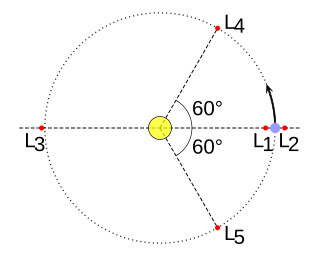
5261 Eureka is the first Mars trojan discovered. It was discovered by David H. Levy and Henry Holt at Palomar Observatory on 20 June 1990. It trails Mars (at the L5 point) at a distance varying by only 0.3 AU during each revolution (with a secular trend superimposed, changing the distance from 1.5–1.8 AU around 1850 to 1.3–1.6 AU around 2400). Minimum distances from Earth, Venus, and Jupiter, are 0.5, 0.8, and 3.5 AU, respectively.
Mount Lemmon Survey (MLS) is a part of the Catalina Sky Survey with observatory code G96. MLS uses a 1.52 m (60 in) cassegrain reflector telescope operated by the Steward Observatory at Mount Lemmon Observatory, which is located at 2,791 meters (9,157 ft) in the Santa Catalina Mountains northeast of Tucson, Arizona.

In astronomy, a trojan is a small celestial body (mostly asteroids) that shares the orbit of a larger body, remaining in a stable orbit approximately 60° ahead of or behind the main body near one of its Lagrangian points L4 and L5. Trojans can share the orbits of planets or of large moons.
In astronomy, a co-orbital configuration is a configuration of two or more astronomical objects orbiting at the same, or very similar, distance from their primary, i.e. they are in a 1:1 mean-motion resonance..

The Mars trojans are a group of trojan objects that share the orbit of the planet Mars around the Sun. They can be found around the two Lagrangian points 60° ahead of and behind Mars. The origin of the Mars trojans is not well understood. One theory suggests that they were primordial objects left over from the formation of Mars that were captured in its Lagrangian points as the Solar System was forming. However, spectral studies of the Mars trojans indicate this may not be the case. Another explanation involves asteroids chaotically wandering into the Mars Lagrangian points later in the Solar System's formation. This is also questionable considering the short dynamical lifetimes of these objects. The spectra of Eureka and two other Mars trojans indicates an olivine-rich composition. Since olivine-rich objects are rare in the asteroid belt it has been suggested that some of the Mars trojans are captured debris from a large orbit-altering impact on Mars when it encountered a planetary embryo.

(121514) 1999 UJ7 is a small asteroid orbiting near the L4 point of Mars (60 degrees ahead Mars on its orbit). As of September 2011, it is the only known asteroid to orbit the leading L4 point of Mars, although at least three other asteroids orbit Mars's trailing L5 point: 5261 Eureka, (101429) 1998 VF31, and 2007 NS2. Not only does (121514) 1999 UJ7 orbit on the other side of Mars from other similar asteroids, its spectrum is different as well, which is puzzling because all of the Martian trojans seem to be in very stable orbits.

(101429) 1998 VF31 is a sub-kilometer asteroid that orbits near Mars's L5 Lagrangian point, on average trailing 60° behind it. Its orbit is highly stable, and was originally thought to be spectroscopically similar to 5261 Eureka, suggesting they may both be primordial Martian asteroids.

(311999) 2007 NS2 is an asteroid and Mars trojan orbiting near the L5 point of Mars.

(385250) 2001 DH47, provisional designation 2001 DH47, is a sub-kilometer asteroid and Mars trojan orbiting 60° behind the orbit of Mars near the L5 point.

2011 SC191 is a small asteroid and Mars trojan orbiting near the L5 point of Mars (60 degrees behind Mars on its orbit).

2011 UN63, also written as 2011 UN63, is a Mars trojan, an asteroid orbiting near the L5 point of Mars (60 degrees behind Mars on its orbit).
2012 XE133 is an asteroid, classified as near-Earth object of the Aten group that is a temporary co-orbital of Venus.

Asteroid 2011 QF99 is a minor planet from the outer Solar System and the first known Uranus trojan to be discovered. It measures approximately 60 kilometers (37 miles) in diameter, assuming an albedo of 0.05. It was first observed 29 August 2011 during a deep survey of trans-Neptunian objects conducted with the Canada–France–Hawaii Telescope, but its identification as Uranian trojan was not announced until 2013.

2009 SE is a small asteroid and Mars trojan orbiting near the L5 point of Mars (60 degrees behind Mars on its orbit).

2018 EC4 is a small asteroid and Mars trojan orbiting near the L5 point of Mars (60 degrees behind Mars on its orbit).

2018 FC4 is a small asteroid and Mars trojan orbiting near the L5 point of Mars (60 degrees behind Mars on its orbit).

2011 SP189 is a small asteroid and Mars trojan orbiting near the L5 point of Mars (60 degrees behind Mars on its orbit).

2011 UB256 is a small asteroid and Mars trojan orbiting near the L5 point of Mars (60 degrees behind Mars on its orbit).

2016 CP31 is a small asteroid and Mars trojan orbiting near the L5 point of Mars (60 degrees behind Mars on its orbit).
2020 VT1 is a small asteroid, classified as a near-Earth object of the Amor group, that is a temporary horseshoe companion to Mars.




